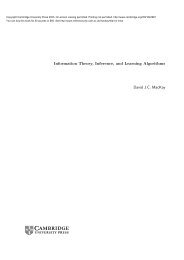Useful Approximate Solutions for Standard ... - MAELabs UCSD
Useful Approximate Solutions for Standard ... - MAELabs UCSD
Useful Approximate Solutions for Standard ... - MAELabs UCSD
You also want an ePaper? Increase the reach of your titles
YUMPU automatically turns print PDFs into web optimized ePapers that Google loves.
9. Estimates <strong>for</strong> stress concentrations<br />
Stresses and strains are concentrated at holes, slots or changes of section in elastic<br />
bodies. Plastic flow, fracture and fatigue cracking start at these places. The local<br />
stresses at the stress concentrations can be computed numerically, but this is often<br />
unnecessary. Instead, they can be estimated using the equation shown on the<br />
facing page.<br />
The stress concentration caused by a change in section dies away at distances of<br />
the order of the characteristic dimension of the section-change (defined more fully<br />
below), an example of St Venant's principle at work. This means that the<br />
maximum local stresses in a structure can be found by determining the nominal<br />
stress distribution, neglecting local discontinuities (such as holes or grooves), and<br />
then multiplying the nominal stress by a stress concentration factor. Elastic stress<br />
concentration factors are given approximately by the equation given in the table. In<br />
it, σ nom is defined as the load divided by the minimum cross-section of the part,<br />
ρ is the minimum radius of curvature of the stress-concentrating groove or hole,<br />
and c is a characteristic dimension: either the half-thickness of the remaining<br />
ligament, the half-length of a contained crack, the length of an edge-crack or the<br />
height of a shoulder, whichever is least. The drawings show examples of each such<br />
situation. The factor α is roughly 2 <strong>for</strong> tension, but is nearer 1/2 <strong>for</strong> torsion and<br />
bending. Though inexact, the equation is an adequate working approximation <strong>for</strong><br />
many design problems.<br />
The maximum stress is limited by plastic flow or fracture. When plastic flow<br />
starts, the strain concentration grows rapidly while the stress concentration remains<br />
constant. The strain concentration becomes the more important quantity, and may<br />
not die out rapidly with distance (St Venant's principle no longer applies).<br />
© Granta Design, January 2009<br />
(Tension)
















